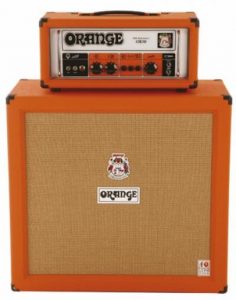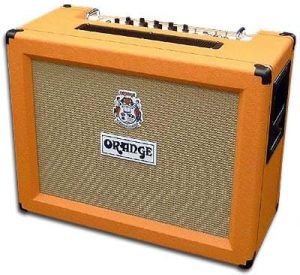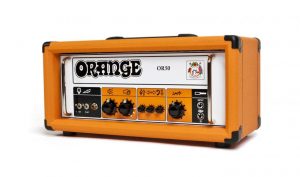Britain’s very own Orange Amps is celebrating its 40th anniversary with this excellent 50W rig. Dave Petersen dodges the balloons and cake and heads straight for his guitar.
To mark its 40th birthday, They introduced this special new model Orange OR50 at this year’s Frankfurt fair in February. It has similar dimensions to the Thunderverb 50 we reviewed in the March issue, but it’s a more simply laid-out amp with a single Gain/Master channel and stripped-down facilities. It’s issued with a cabinet full of Celestion G12H Anniversary specials, whose size will be enough to quell any thoughts of using a pair – for a 50W half-stack, the overall size is impressive.

One or two details of the Orange OR50 distinguish it from Orange’s more recent products. There’s the older ‘graphics-only’ format, with a plexi front panel that departs from Orange’s standard stove-enamelling. It has the different-sized knobs of the first Oranges, and the ‘Fist’ control – the brand’s distinctive mid-high booster that many players use to get some edge with the mellower humbuckers – makes a welcome return.
Features
Table of Contents
New features include a footswitchable Master Defeat, not unlike the Attenuator of the Thunderverb series, designed for easy switching from preset rhythm / comping to commanding solo levels. But the general tendency harks back to the early days of Orange, in line with the anniversary concept.
Orange is still, except for its entry-level models, a UK-built product. Nonetheless the OR50 achieves a significantly lower price than the nearest in the range without any obvious drop in quality. We find the same stove-enamelled steel chassis, high-grade switches, jacks and valves as in the 40 per cent higher-priced Thunderverbs, and, as in these. The circuit benefits sonically from choke filtering, generally the high-priced option. The cabinetry is solidly made from 18mm plywood with high standards of covering work and finish. Although the airline-driven back panel fixing screws were in too tight to permit an internal inspection. Steel grabs and corner protectors round off the impression of solid roadability. But we were puzzled by the lack of receptacles for the castors Orange had included. This is worth checking with your dealer as presumably some of the cabs are issued with them fitted. And at these weights they become important.

Sounds Orange OR50
Powering up goes pretty seamlessly. There’s a low mechanical transformer buzz that wouldn’t be audible in stage or even rehearsal conditions. And nigh-on zero noise through the speakers at midpoint settings. Although the preamp isn’t gated off with no jack inserted. Advancing the Gain and Master to max doesn’t change this impression much. In fact the Orange OR50 exceptionally quiet. That’s partly because behind the plexi fascia is a steel panel which acts as a screen between the guitar. And the electromagnetic field from the mains transformer, allowing single-coil players to get nearer the amp without picking up too much splash. It all adds to the comfort factor.
Stratted-up at the 12 o’clock start point, the Orange OR50 a very lively customer indeed. It has the bright but tough Orange signature. With smooth tone controls that are better for trimming the sound than defining it. Firm playing begins to push the amp into its crunch area at this setting. And more Gain brings on full saturation very quickly. In fact advancing from 5/10 to 7/10 changes the amp from a solid rhythm choogler to a bluesy wailer. This aspect of the amp deserves attention. Because small Gain setting changes are important. It’s even more emphatic with the Gibson SG, which we think brings out the best in the OR50. Chords with the most solid-but-edgy crunch you could want, great composure at full gig levels, and fluid, overtoned, clear leads if you defeat the Master with the footswitch.

Many premier-league bands use SG/Orange with this in mind – a modeller it ain’t. But it does this blues-rock three-piece stuff incomparably well.
Control
Pushing the Gain takes you into fuzzier territory, where it’s easy to create late ’60s hooting, buzzy tones, more Tonebender than Tube Screamer. In this air, where the Strat struggles to maintain height, the SG feels more at home. And a good dose of the Fist control helps it to cut through without fizzing, undertoning, or trying to be a synth. Not that the OR50 doesn’t give a good Strat sound – it does, with careful settings. It’s just that the SG brings out its excellence more readily.
We’ve mainly considered the Orange OR50 distortion qualities because that’s the market for half-stack 50’s. But it’s also worth trying the amp as a big clean boomer. It’s got a fullness of tone that combos can’t get near. With a fine chiming treble supported by chest-flapping bass. This puts it a notch better than the Thunderverb in the clean power table. And we also felt an irresistible curiosity about how it would sound with a bass. There went the rest of the afternoon.
Verdict Orange OR50
The OR50’s strength is in the way it handles awkward guitar jobs. Plenty of amps sound good with Strats for clean work, some sound decent enough with SG’s for lead. Very few carry an SG for rhythm and lead, and a good Strat sound narrows the field to two. One is the Orange OR50, and it’s not the most expensive.

Leave a Reply
You must be logged in to post a comment.